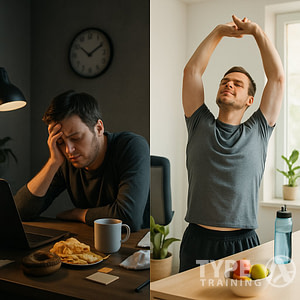Yoga has been practiced for centuries and has become increasingly popular in recent years due to its numerous health benefits. One of the most significant benefits of yoga is its ability to reduce stress and promote relaxation. Stress is a common problem that affects many people, and it can lead to a range of physical and mental health issues. Practicing yoga can help reduce stress levels, calm the mind, and promote a sense of inner peace.
Incorporating Simple Yoga Poses for Relieve Stress into your daily routine can greatly enhance your mental well-being.
There are many different yoga poses that can be used to relieve stress and promote relaxation. These poses are designed to stretch and strengthen the body while also calming the mind. Some of the most effective yoga poses for stress relief include forward bends, backbends, and twists. Forward bends are particularly effective for reducing stress as they help to calm the mind and release tension in the neck, shoulders, and back. Backbends can also be useful for relieving stress as they help to open up the chest and lungs, which can promote deep breathing and relaxation. Twists are another effective yoga pose for stress relief as they help to release tension in the spine and promote relaxation throughout the body.
These Simple Yoga Poses for Relieve Stress offer a straightforward way to achieve a tranquil state of mind.
Popular posts:
The Importance of Yoga Poses for Stress Relief
Why Yoga?
Yoga is a holistic practice that combines physical postures, breathing techniques, and meditation to promote mental and physical well-being. It has been shown to be an effective tool for reducing stress, anxiety, and depression, and improving overall mood. Practicing yoga regularly can help individuals develop greater awareness of their bodies and minds, and cultivate a sense of inner peace and balance.
Engaging in Simple Yoga Poses for Relieve Stress can significantly improve your quality of life.
How Yoga Poses Help Relieve Stress
Yoga poses, or asanas, can be an effective way to release tension and reduce stress in the body. Many yoga postures involve stretching and relaxing the muscles, which can help to release built-up tension in areas like the shoulders, chest, spine, hips, and lower back. Certain poses, like the standing forward bend and kneeling position, target the hip joint and buttocks, where many people hold tension.
In addition to physical benefits, yoga poses can also have a positive impact on mental health. Practicing postures like the child’s pose and the corpse pose can help individuals to cultivate a sense of deep relaxation and inner peace. This can help to reduce anxiety and promote a more positive mood.
The 5 Best Yoga Poses for Stress Relief
Individuals often find comfort in Simple Yoga Poses for Relieve Stress, which can be practiced anywhere.
Here are five yoga poses that are particularly effective for relieving stress: 5 Simple Yoga Poses for Relieve Stress. Balasana (Child’s Pose) is a calming posture that can help reduce stress and anxiety levels.
Exploring different Simple Yoga Poses for Relieve Stress can help you discover what works best for you.
Balasana (Child’s Pose) Comprehensive Report:
Balasana, a gentle resting pose, calms the nervous system and releases tension in the back, shoulders, and hips. Perfect for beginners and advanced practitioners alike.
Practicing Simple Yoga Poses for Relieve Stress not only benefits the body but also the mind.
Preparation
- Begin kneeling on your mat with knees hip-width apart, big toes touching.
- Sit back on your heels, maintaining a straight spine.
Execution
- Exhale deeply and bow forward, lowering your torso between your thighs.
- Extend arms forward alongside your ears, palms resting on the mat.
- Alternatively, rest arms alongside your body, palms facing up.
- Allow your forehead to gently touch the mat.
Deepening
- Sink hips toward heels while keeping shoulders relaxed away from ears.
- Breathe deeply, sending breath to your back and any areas of tension.
- For tight hips, widen knees further apart while keeping big toes touching.
Completion
- Hold for 30 seconds to several minutes, breathing normally.
- To exit, plac
This restorative pose calms the mind, relieves tension, and gently stretches the spine, shoulders, and hips.
Remember that Simple Yoga Poses for Relieve Stress should be done with mindfulness and intention.
Uttanasana (Standing Forward Bend)
Uttanasana, a rejuvenating forward fold, stretches the entire posterior chain while calming the nervous system. This fundamental yoga pose improves circulation to the brain, relieves tension in the spine, hamstrings, and calves, and can help reduce anxiety and fatigue. Practice it both as a standalone pose or within flowing sequences.
Preparation
- Begin kneeling on your mat with knees hip-width apart, big toes touching.
- Sit back on your heels, maintaining a straight spine.
Execution
- Exhale deeply and bow forward, lowering your torso between your thighs.
- Extend arms forward alongside your ears, palms resting on the mat.
- Alternatively, rest arms alongside your body, palms facing up.
- Allow your forehead to gently touch the mat.
Deepening
- Sink hips toward heels while keeping shoulders relaxed away from ears.
- Breathe deeply, sending breath to your back and any areas of tension.
- For tight hips, widen knees further apart while keeping big toes touching.
Completion
- Hold for 30 seconds to several minutes, breathing normally.
- To exit, place palms under shoulders and slowly roll up to sitting position.
This restorative pose calms the mind, relieves tension, and gently stretches the spine, shoulders, and hips.
Sukhasana (Easy Pose)
Integrating Simple Yoga Poses for Relieve Stress daily can lead to a more balanced lifestyle.
Sukhasana, or Easy Pose, is a foundational seated meditation posture that promotes inner calm and proper spinal alignment. Despite its simple appearance, this cross-legged position creates a stable base for pranayama and meditation practices while gently opening the hips and encouraging proper posture for both beginners and experienced practitioners alike.
Preparation
- Begin by sitting on your mat with legs extended in front of you.
- Fold one leg in, bringing the foot under the opposite thigh.
Execution
- Fold the other leg in, crossing ankles or placing each foot beneath the opposite knee.
- Position knees wide enough for comfort, ideally resting toward the floor.
- Align your spine by sitting on the edge of a folded blanket if needed.
- Rest hands on knees, palms up or down, or create a mudra with fingers.
Deepening
- Relax shoulders away from ears while lengthening through the crown of your head.
- Soften your facial muscles and bring awareness to your natural breath.
- For tight hips, elevate your seat using a cushion or folded blanket.
Completion
- Hold for 1-5 minutes, breathing normally and maintaining awareness.
- Release the pose by extending legs forward and gently moving the hips.
This accessible pose encourages proper breathing, reduces anxiety, and prepares the body and mind for deeper meditation practices.
Many people turn to Simple Yoga Poses for Relieve Stress as a reliable method for relaxation.
Marjaryasana-Bitilasana (Cat-Cow Pose)
Marjaryasana-Bitilasana, the rhythmic Cat-Cow flow, synchronizes breath with spinal movement to improve flexibility and circulation. This gentle, accessible sequence warms the body, relieves back tension, stimulates abdominal organs, and coordinates breath awareness—making it perfect for beginners, prenatal practice, and as preparation for more challenging poses.
Preparation
- Begin on hands and knees in a tabletop position with wrists under shoulders.
- Align knees under hips, keeping spine neutral and gaze downward.
Execution
- For Cow Pose (Bitilasana): Inhale deeply while lifting chest and tailbone toward ceiling.
- Allow belly to sink toward the floor as you gently arch your back.
- Look slightly upward without compressing the neck.
- For Cat Pose (Marjaryasana): Exhale while rounding your spine toward the ceiling.
- Draw navel toward spine and tuck chin toward chest.
- Release crown of head toward floor without straining.
Deepening
- Move smoothly between poses, coordinating each movement with breath.
- Focus on articulating each vertebra during the transition.
- Keep shoulders relaxed and elbows soft throughout the flow.
Completion
- Perform 5-10 complete cycles at a comfortable pace.
- Return to neutral tabletop position before transitioning to another pose.
This flowing sequence improves posture, balance, and coordination while massaging internal organs and relieving stress.
Incorporating Simple Yoga Poses for Relieve Stress can be transformative for your mental health.
Savasana (Corpse Pose)
Savasana, though appearing simple, is considered yoga’s most challenging pose—the art of conscious relaxation. This essential closing posture allows the body to absorb practice benefits, reduces
Preparation
- Lie flat on your back with legs comfortably extended and feet falling naturally outward.
- Place arms alongside your body, palms facing upward for receptivity.
Execution
- Position your head in a neutral alignment, centered between shoulders.
- Close your eyes and allow your whole body to become heavy against the mat.
- Slightly tuck your chin to lengthen the back of your neck.
- Relax your facial muscles—soften the space between eyebrows, jaw, and tongue.
Deepening
- Mentally scan your body from toes to crown, releasing tension in each area.
- Allow your breath to become natural and effortless without control.
- Surrender completely, letting go of any urge to adjust or fidget.
Completion
- Remain in Savasana for 5-15 minutes (longer than most other poses).
- To exit, deepen your breath, wiggle fingers and toes, then roll to one side before slowly sitting up.
This profound relaxation pose cultivates present-moment awareness while granting the nervous system vital time to reset and restore balance.
Consider making Simple Yoga Poses for Relieve Stress a part of your wellness journey.
Overall, practicing yoga poses regularly can be an effective way to reduce stress and promote mental and physical well-being. By cultivating awareness, balance, and resilience, individuals can develop a greater sense of calm and inner peace in their daily lives.
Related Post
Simple Yoga Poses for Relieve Stress can be the key to unlocking inner peace.
The Benefits of Yoga Poses for Stress Relief
Yoga is a powerful tool for managing stress. Its combination of physical postures, deep breathing, and mindfulness promotes relaxation and reduces the production of stress hormones. This leads to a decrease in anxiety and a greater sense of calm.
Integrating Simple Yoga Poses for Relieve Stress into your routine is a great way to build resilience.
Yoga instructor, B.K.S. Iyengar, once said, “Yoga teaches us to cure what need not be endured and endure what cannot be cured.” This philosophy is reflected in the practice of yoga for stress relief. Rather than simply managing stress, yoga helps individuals develop the skills to better cope with stressors in their lives.
In addition to its mental benefits, yoga also has physical benefits that can help reduce stress. The physical postures, or asanas, help to release tension in the body and promote flexibility. This can help individuals feel more relaxed and comfortable in their bodies, which can in turn lead to a greater sense of calm.
Concentration is another key component of yoga that can help reduce stress. By focusing on the breath and the movements of the body, individuals are able to quiet their minds and let go of distracting thoughts. This can help them feel more centered and present in the moment, which can reduce feelings of stress and anxiety.
Finally, yoga can bring joy to individuals who practice it regularly. The sense of accomplishment that comes from mastering a new pose or completing a challenging class can boost mood and self-esteem. This can help individuals feel more positive and resilient in the face of stressors.
Overall, yoga poses are a valuable tool for managing stress. By promoting relaxation, reducing tension in the body, increasing concentration, and bringing joy, yoga can help individuals better cope with stressors in their lives.
Many individuals find that Simple Yoga Poses for Relieve Stress help them connect with their inner selves.
Breathing Techniques to Enhance the Benefits of Yoga Poses
Breathing techniques play an essential role in enhancing the benefits of yoga poses for stress relief. By focusing on the breath, yogis can calm their minds, reduce anxiety, and promote relaxation. Here are some breathing techniques that can help you optimize the benefits of your yoga practice:
Deep Breathing
Deep breathing is a simple yet powerful technique that can help you relax and reduce stress. It involves inhaling deeply through your nose, filling your lungs with air, and exhaling slowly through your mouth. This technique can activate the parasympathetic nervous system, which is responsible for promoting relaxation and reducing stress.
Alternate Nostril Breathing
Alternate nostril breathing is a pranayama technique that involves inhaling through one nostril and exhaling through the other. This technique can help balance the left and right hemispheres of the brain, promote relaxation, and reduce anxiety. It can also stimulate the vagus nerve, which is responsible for regulating the digestive system, sleep, and mood.
Breath of Fire
Breath of fire is a powerful breathing technique that involves rapid, rhythmic breathing through the nose. This technique can help energize the body, increase mental clarity, and reduce stress. It can also stimulate the production of serotonin, a neurotransmitter that is responsible for regulating mood and promoting feelings of happiness.
Cat-Cow Pose
Cat-cow pose is a gentle yoga pose that involves moving the spine through a series of gentle arches and curves. This pose can help relieve tension in the back and neck, promote relaxation, and reduce stress. By coordinating your breath with the movement, you can enhance the benefits of this pose and promote a sense of calm.
Legs-Up-the-Wall Pose
Legs-up-the-wall pose is a restorative yoga pose that involves lying on your back with your legs extended up against a wall. This pose can help promote relaxation, reduce stress, and improve circulation. By focusing on your breath while in this pose, you can enhance the benefits and promote a sense of calm.
In conclusion, breathing techniques can help yogis optimize the benefits of their yoga practice for stress relief. By incorporating deep breathing, alternate nostril breathing, breath of fire, cat-cow pose, and legs-up-the-wall pose into their practice, yogis can promote relaxation, reduce stress, and improve their overall well-being.
Other Yoga Styles and Practices that Help with Stress Relief
Utilizing Simple Yoga Poses for Relieve Stress can elevate your yoga practice to new heights.
While there are many yoga asanas that can help reduce stress and promote relaxation, there are also other yoga styles and practices that can be beneficial. These styles and practices focus on different aspects of yoga, such as the inward focus, breathing exercises, and the sympathetic nervous system.
One such style is yin yoga, which involves holding poses for longer periods of time, usually 3-5 minutes or more. This style of yoga is known for its ability to calm the mind and reduce negative thoughts. Yin yoga also helps to release tension in the body, particularly in the psoas and groin areas.
Another practice that can be helpful for stress relief is inward focus. This involves turning the attention inward, away from external distractions and towards the present moment. Inward focus can be achieved through a variety of techniques, such as meditation, visualization, and mindfulness.
Breathing exercises are also an effective way to reduce stress and promote relaxation. These exercises can be done in conjunction with yoga asanas or on their own. One popular exercise is the 4-7-8 breath, which involves inhaling for 4 seconds, holding the breath for 7 seconds, and exhaling for 8 seconds.
Hatha yoga is another style that can be helpful for stress relief. This style of yoga focuses on the physical postures, or asanas, and is often taught in a slow and gentle manner. Popular asanas for stress relief include downward facing dog and mountain pose.
Finally, legs up the wall is a restorative yoga pose that can be done with the support of a folded blanket and a neck roll. This pose helps to reduce fatigue and promote relaxation by reversing the flow of blood and lymphatic fluid in the body.
Overall, there are many yoga styles and practices that can be helpful for stress relief. By incorporating these practices into their routine, individuals can experience greater relaxation and a greater sense of calmness in their daily lives.
Incorporating Yoga Poses into Your Daily Routine
Incorporating yoga poses into your daily routine can be an effective way to manage stress and ground yourself in the present moment. Doing so can help you adapt to the demands of daily life while also preparing you for whatever the future may hold.
One of the key components of yoga is breathwork. By focusing on your breath during yoga poses, you activate your parasympathetic nervous system, which helps to counteract the stress response. This can help you feel more relaxed and centered, even in the midst of a busy day.
Another benefit of incorporating yoga poses into your daily routine is that it can help you break a sweat. Sweating is a natural way to release toxins from your body and can also help to relieve stress.
When it comes to stress management, there are a variety of yoga poses that have stress-relieving benefits. For example, the child’s pose is a gentle forward bend that can help to calm the mind and release tension in the back. The downward-facing dog is another pose that can help to relieve stress by stretching the hamstrings and releasing tension in the neck and shoulders.
For those dealing with daily stress, Simple Yoga Poses for Relieve Stress can be particularly beneficial.
To make it easier to incorporate yoga poses into your daily routine, consider setting aside a specific time each day to practice. This could be first thing in the morning, during your lunch break, or before bed. You could also try doing a few poses throughout the day whenever you have a few spare minutes.
In conclusion, incorporating yoga poses into your daily routine can be a powerful tool for managing stress and promoting overall well-being. By focusing on your breath, breaking a sweat, and practicing stress-relieving poses, you can ground yourself in the present moment and feel more prepared to handle whatever challenges come your way.
Embracing Simple Yoga Poses for Relieve Stress is a step towards a healthier and happier life.






